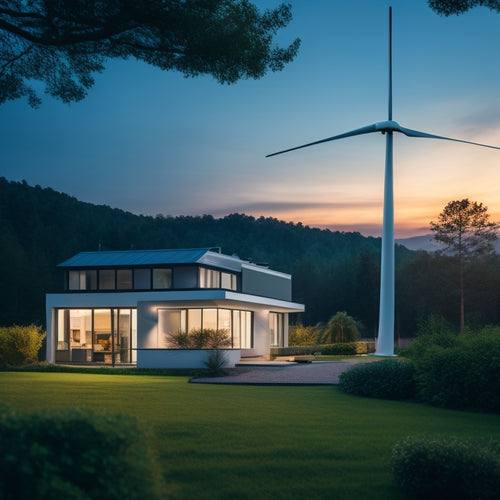
Honda Unveils Green Driving Revolution With EVS
Share
Honda pioneers a sustainable transportation revolution with its electric vehicle (EV) lineup, spearheaded by the fully-electric Prologue SUV. This emissions-reducing vehicle is powered by advanced rechargeable battery technology, promoting a cleaner environment with zero-emission commutes. Supporting this eco-friendly initiative, Honda provides convenient charging options, including Level 1, Level 2, and Quick Charging, with an accessible network of charging stations. To fully harness the benefits of EVs, an expanding infrastructure of charging stations is strategically located in metropolitan areas and along freeways. Explore further to discover how Honda's innovative approach is shaping the future of green driving.
Key Takeaways
• Honda's Prologue, a fully-electric SUV, promises emissions reduction and a reduced carbon footprint with its rechargeable battery technology.
• The Prologue ensures a zero-emission commute, promoting a cleaner environment and guilt-free driving.
• Honda's electric vehicle lineup focuses on providing eco-friendly transportation options, aligning with growing environmental demands.
• Multiple charging options, including Level 1, Level 2, and Quick Charging, cater to varying driver needs and convenience levels.
• An expanding network of conveniently located charging stations enables drivers to access EV benefits and reduce their carbon footprint.
Honda's Electric Vehicle Lineup
Honda's inaugural foray into the electric vehicle market is spearheaded by the Prologue, a fully-electric SUV slated for release in 2024, which promises a sustainable transportation option that guarantees emissions reduction and reduces carbon footprint with every drive.
This pioneering model is powered solely by a rechargeable battery, harnessing advanced battery technology to minimize environmental impact. By adopting electric propulsion, Honda aims to provide a guilt-free driving experience, aligning with the growing demand for eco-friendly transportation solutions.
The Prologue's electric powertrain guarantees a zero-emission commute, reducing greenhouse gas emissions and promoting a cleaner environment. With its commitment to sustainability, Honda is poised to revolutionize the automotive landscape, catering to environmentally conscious consumers seeking a greener driving experience.
Charging Options Explained
The electric vehicle (EV) charging process, an essential aspect of EV ownership, relies on three primary charging methods: Level 1, Level 2, and Quick Charging (Level 3), each offering varying speeds and convenience levels to accommodate diverse driving needs and lifestyles.
| Charging Method | Charging Speed | Installation Requirements |
|---|---|---|
| Level 1 | 2-5 miles per hour | No installation required, uses standard outlet |
| Level 2 | 10-20 miles per hour | May require professional installation at home |
| Quick Charging (Level 3) | Up to 60 miles in 10 minutes | Dedicated stations requiring subscription or payment |
| May require energy sources like solar or wind power |
When considering EV ownership, it's essential to understand the charging options available, including their charging speeds, affordability, and installation process. Honda's EV offerings prioritize sustainability and environmental consciousness, making them an attractive option for those seeking an eco-friendly transportation solution.
Accessing EV Charging Infrastructure
In addition to the charging methods, an extensive network of accessible charging stations is essential for widespread EV adoption, and fortunately, the infrastructure is rapidly expanding to meet the growing demand.
A charging station finder facilitates easy discovery of nearby stations, ensuring seamless EV charging experiences. As the network grows, EV owners can reap the benefits of sustainable energy, reducing their carbon footprint with every drive.
Charging station accessibility is key, with many stations conveniently located in metropolitan areas, shopping centers, and along freeways. This expanding infrastructure enables drivers to effortlessly access EV charging benefits, fostering a greener driving revolution.
Frequently Asked Questions
Can I Install a Level 2 Charging Station in My Garage?
'Can you install a Level 2 charging station in your garage? Absolutely, but first, make sure your garage's wiring can support the increased electrical load, consulting an electrician if necessary, to guarantee a safe and efficient charging experience.'
Are Electric Vehicles More Expensive to Insure Than Gas-Powered Cars?
Comparing insurance rates, electric vehicles (EVs) are often pricier to insure than gas-powered cars, due to higher EV cost analysis, including advanced technology and battery replacement expenses, leading to increased premiums.
Do Electric Vehicles Require More Frequent Brake Replacements?
Electric vehicles typically require less frequent brake replacements due to regenerative braking, which reduces wear on brake pads and rotors, enhancing brake performance and extending lifespan, resulting in lower maintenance costs.
Can I Tow an Electric Vehicle if It Runs Out of Charge?
When an electric vehicle runs out of charge, towing is possible, but extreme caution is essential to guarantee Tow Safety. Roadside Assistance services, like those offered by EV manufacturers, can provide specialized towing equipment and trained operators to safely transport the vehicle to a charging station.
Are There Any Government Incentives for Buying an Electric Vehicle?
Yes, government incentives for buying an electric vehicle include Federal tax credits of up to $7,500 and State rebates, varying by location, to encourage sustainable transportation and reduce environmental impact.
Related Posts
-

3 Earth-Loving Furniture Tips for Energy-Smart Homes
When furnishing your energy-smart home, you have the power to reduce your carbon footprint greatly by making consciou...
-

10 Grid-Tied Wind Power Systems for Modern Homes
You're looking for a grid-tied wind power system to utilize wind energy for your modern home. Here are ten options to...
-

What Air Purifiers Save Energy in Work Areas?
You can cut energy costs and reduce your carbon footprint by choosing air purifiers designed with energy efficiency i...


